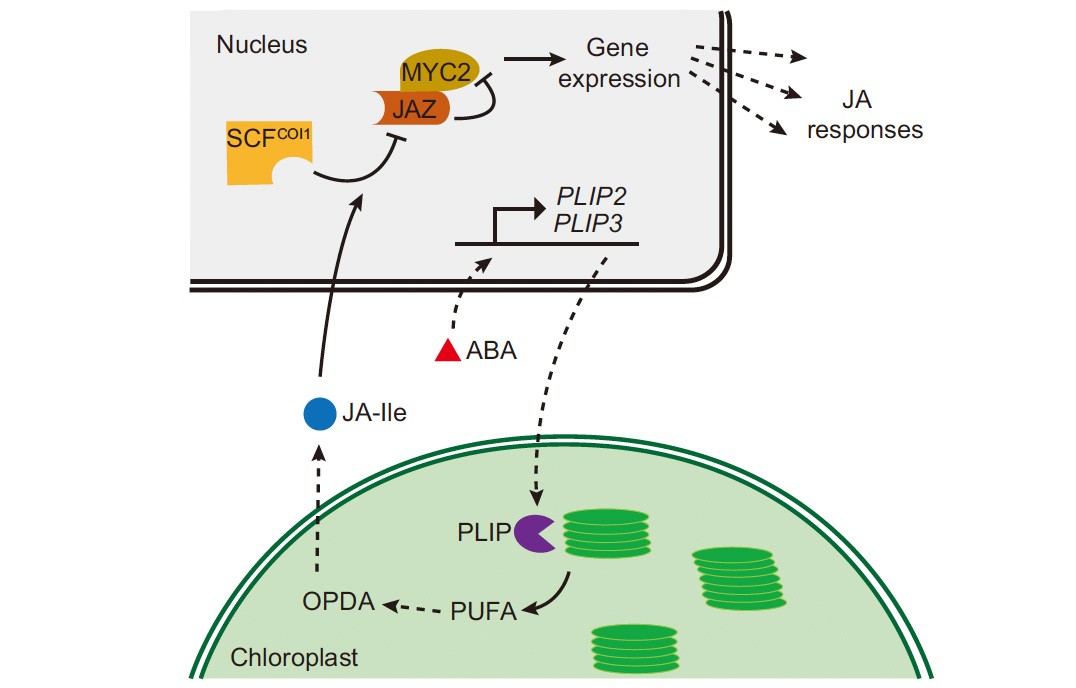博文
Plant Cell:两个响应ABA的质体脂酶基因参与JA生物合成
||
Two Abscisic Acid Responsive Plastid Lipase Genes Involved in Jasmonic Acid Biosynthesis in Arabidopsis thaliana
First author: Kun Wang; Affiliations: Michigan State University (密歇根州立大学): Michigan, USA
Corresponding author: Christoph Benning
Chloroplast membranes with their unique lipid composition are crucial for photosynthesis. Maintenance of the chloroplast membranes requires finely tuned lipid anabolic and catabolic reactions. Despite the presence of a large number of predicted lipid-degrading enzymes in the chloroplasts, their biological functions remain largely unknown. Recently, we described PLASTID LIPASE1 (PLIP1), a plastid phospholipase A1 (质体磷脂酶A1) that contributes to seed oil biosynthesis. The Arabidopsis thalianagenome encodes two putative PLIP1 paralogs, which we designated PLIP2 and PLIP3. PLIP2 and PLIP3 are also present in the chloroplasts, but likely with different subplastid locations. In vitro analysis indicated that both are glycerolipid A1 lipases (甘油脂A1脂酶). In vivo, PLIP2 prefers monogalactosyldiacylglycerol (单半乳糖基二酰基甘油) as substrate and PLIP3 phosphatidylglycerol (磷脂酰甘油). Overexpression of PLIP2or PLIP3severely reduced plant growth and led to accumulation of the bioactive form of jasmonate and related oxylipins (氧化脂类). Genetically blocking jasmonate perception restored the growth of the PLIP2/3overexpressing plants. The expression of PLIP2and PLIP3, but not PLIP1was induced by abscisic acid (ABA), and plip1 plip2 plip3triple mutants exhibited compromised oxylipin biosynthesis in response to ABA. The pliptriple mutants also showed hypersensitivity to ABA. We propose that PLIP2 and PLIP3 provide a mechanistic link between ABA-mediated abiotic stress responses and oxylipin signaling.
叶绿体膜具有其独特的脂质组成,对于光合作用十分重要。叶绿体膜的维持需要精细的脂质合成代谢和分解代谢调控。目前已经证实了很多之前预测的在叶绿体中存在的脂质降解酶,然而这些酶的生物学功能还有待进一步的研究。近来,作者鉴定了一个质体磷脂酶A1 PLIP1,作用于种子油的生物合成。拟南芥基因组中还存在两个编码PLIP1旁系同源的基因,作者将其命名为PLIP2和PLIP3。PLIP2和PLIP3同样在叶绿体中存在,但可能分布在不同的亚质体部位。体外试验显示这两个酶都是属于甘油脂A1脂酶。体内试验表明PLIP2更喜好单半乳糖基二酰基甘油作为低物,而PLIP3更喜好磷脂酰甘油。过表达PLIP2或者PLIP3均能严重减少植物的生长,并导致过量积累具有生物活性的茉莉酸和氧化脂类。通过遗传方法阻断茉莉酸的感知能够恢复PLIP2或者PLIP3过表达植株的表型。脱落酸ABA能够诱导PLIP2和PLIP3的表达,但不能诱导PLIP1的表达。plip1 plip2 plip3三突变体在响应ABA处理时存在氧化脂类生物合成的。同时,plip三突变体植株还对ABA超敏感。作者认为PLIP2和PLIP3连接了ABA介导的非生物胁迫响应与氧化脂类信号转导之间的联系。
通讯:Christoph Benning (https://prl.natsci.msu.edu/people/faculty/christoph-benning/)
个人简介:1986年,弗萊堡大学,硕士;1991年,密歇根州立大学,博士。
研究方向:光合作用物种中的脂质代谢。
doi: https://doi.org/10.1105/tpc.18.00250
Journal: Plant Cell
First Published date: 17 April, 2018
(P.S. 欢迎关注微信公众号:微信号Plant_Frontiers)
https://blog.sciencenet.cn/blog-3158122-1109705.html
上一篇:New Phytologist:东亚植物物种多样性高的解释
下一篇:Plant Biotechnol J:水稻OsPK2基因参与胚乳淀粉合成和籽粒灌浆
全部作者的其他最新博文
- • Plant Physiology:CsMADS3促进柑果中的叶绿素降解和类胡萝卜素合成(华中农业大学)
- • Molecular Plant:LBD11-ROS反馈调节作用于拟南芥的维管形成层增殖和次生生长(浦项科技大学)
- • Science Advances:根结线虫通过调控植物的CLE3-CLV1模块,促进侵染进程(日本熊本大学)
- • Nature Communications:油菜素内酯参与植物营养生长期转变的分子机制解析(浙江农林大学)
- • Current Biology:光合作用产生的蔗糖驱动侧根“生物钟”(德国弗莱堡大学)
- • PNAS:花同源异型基因在叶中被抑制、花中被激活的分子机制(南卡罗来纳大学)

